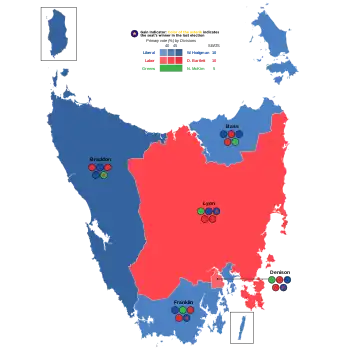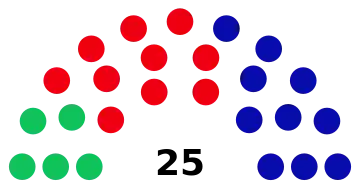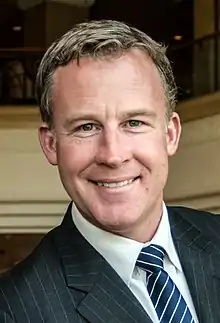| |||||||||||||||||||||||||||||||||||||||||||||
All 25 seats to the House of Assembly 13 seats needed for a majority | |||||||||||||||||||||||||||||||||||||||||||||
|---|---|---|---|---|---|---|---|---|---|---|---|---|---|---|---|---|---|---|---|---|---|---|---|---|---|---|---|---|---|---|---|---|---|---|---|---|---|---|---|---|---|---|---|---|---|
| |||||||||||||||||||||||||||||||||||||||||||||
 Election results and largest party by first preference by division | |||||||||||||||||||||||||||||||||||||||||||||
| |||||||||||||||||||||||||||||||||||||||||||||
The 2010 Tasmanian state election was held on 20 March 2010 to elect members to the Tasmanian House of Assembly.[1] The 12-year incumbent Labor government, led by Premier of Tasmania David Bartlett, won a fourth consecutive term against the Liberal opposition, led by Will Hodgman, after Labor formed a minority government with the support of the Greens.
The election was conducted by the Tasmanian Electoral Commission, an independent body answerable to Parliament. As in past Tasmanian state elections, the proportional Hare-Clark system was used to allocate the 25 seats in the House. The commission announced that there were 357,315 enrolled electors at the close of rolls.[2] A total of 89 candidates nominated for election.[3]
Dates
On 17 November 2008, David Bartlett announced his government's intention to pass legislation enacting fixed electoral terms for Tasmania, with the next election scheduled to be held on 20 March 2010.[4] It was noted by ABC election analyst Antony Green that the date was the same as the already-legislated South Australian election, and that this may have an effect on media coverage of both elections.[5] The draft legislation for the bill was referred to the Select Committee on the Working Arrangements of Parliament in October 2009, although Bartlett confirmed that the government was committed to the 20 March election date despite the fixed-term legislation not being enacted.[6]
On 12 February 2010, the Premier visited the Governor of Tasmania, Peter Underwood, to request that he dissolve the House of Assembly and issue the writs for the election. The Governor agreed to the following election dates:[7]
- 19 February 2010: Issue of writs and close of electoral rolls
- 4 March 2010: Close of candidate nominations
- 5 March 2010: Announcement of candidate nominations
- 20 March 2010: Polling day
Campaign
On 8 February, the Premier announced that Tasmania's first televised leaders' debate would be held on 14 March between himself and opposition leader Will Hodgman, and would be broadcast nationally by Sky News.[8] At the time of the announcement, Mr Hodgman was not aware of the debate and Greens leader Nick McKim was not invited.[9]
On 10 March, around 100 forest workers protested outside the Greens official campaign launch.[10]
On 12 March, two Liberal and two Labor ex-premiers—Paul Lennon, Michael Field, Robin Gray and Tony Rundle—issued a joint press release warning voters of the dangers of minority government with the Greens holding the balance of power.[11]
In the week before the election, the Labor party distributed leaflets alleging that the Greens had a plan to legalise heroin and give "violent criminals" the right to vote.[12] In addition, 20,000 automated phone calls (robocalls) were made to residents of Braddon repeating these claims about the Greens, although Labor ended the campaign after a public backlash.[13]
On 15 March, David Bartlett said he would resign if the Liberal party won more seats than Labor.[14]
Polling
Polling was conducted every three months by Enterprise Marketing and Research Services (EMRS). The sample size for each poll was 1,000 Tasmanian voters.[15]
| Date | Political parties | ||||||
|---|---|---|---|---|---|---|---|
| ALP | Lib | Grn | Ind | Undecided | |||
| Feb 2010 | 23% | 30% | 22% | 2% | 23% | ||
| Nov 2009 | 26% | 37% | 17% | 2% | 19% | ||
| Aug 2009 | 26% | 33% | 17% | 2% | 22% | ||
| May 2009 | 33% | 27% | 13% | 3% | 24% | ||
| Feb 2009 | 34% | 29% | 15% | 2% | 20% | ||
| Nov 2008 | 30% | 26% | 18% | 1% | 23% | ||
| Aug 2008 | 30% | 30% | 16% | 1% | 23% | ||
| May 2008 | 25% | 31% | 18% | 2% | 22% | ||
| Polling conducted by EMRS. | |||||||
| Date | Labor Bartlett |
Liberal Hodgman |
Green McKim |
|---|---|---|---|
| Feb 2010 | 29% | 34% | 21% |
| Nov 2009 | 28% | 40% | 19% |
| Aug 2009 | 30% | 37% | 15% |
| May 2009 | 39% | 31% | 13% |
| Feb 2009 | 41% | 29% | 12% |
| Polling conducted by EMRS. ^ Remainder were "uncommitted" or "undecided" to any leader. | |||
Results
 | ||||||
|---|---|---|---|---|---|---|
| Party | Votes | % | +/– | Seats | +/– | |
| Liberal | 124,933 | 38.99 | 10 | |||
| Labor | 118,168 | 36.88 | 10 | |||
| Greens | 69,233 | 21.61 | 5 | |||
| Socialist Alliance | 646 | 0.20 | 0 | |||
| Independents | 7,458 | 2.33 | 0 | |||
| Total | 320,438 | 100.00 | – | 25 | – | |
| Valid votes | 320,438 | 95.55 | ||||
| Invalid/blank votes | 14,915 | 4.45 | ||||
| Total votes | 335,353 | 100.00 | – | |||
| Registered voters/turnout | 357,315 | 93.85 | ||||
| Source: Tasmanian Electoral Commission | ||||||
Primary vote by division
| Bass | Braddon | Denison | Franklin | Lyons | |
|---|---|---|---|---|---|
| Labor Party | 34.52% | 40.24% | 36.30% | 30.49% | 42.76% |
| Liberal Party | 42.64% | 45.19% | 29.79% | 41.17% | 36.10% |
| Tasmanian Greens | 20.95% | 13.76% | 24.89% | 27.35% | 21.14% |
| Other | 1.89% | 0.80% | 9.01% | 0.99% | 0.00% |
Final distribution of seats
Outcome
Labor lost four seats on a swing of 12.39 percentage points against it, whilst the Liberals gained three seats and the Greens one—the latter recording their highest ever statewide vote of 21.61%. This meant that both the Labor and Liberal Parties had 10 seats each, meaning neither could form majority government. It took over two weeks for the results to be formally declared, although the number of seats for each party was almost certain by the end of counting on the night of the election and the main question was which representatives of each party would win a seat, with the Hare-Clark and Robson rotation systems meaning that some incumbent members on both sides of parliament were defeated by newcomers from their own party.[16] The only inter-party battles for a seat during the counting process were between the Greens and Liberals for the final seat in Braddon (won by the Greens), and between independent Andrew Wilkie and the Liberals for the final seat in Denison (won by the Liberals).
Attention was then focussed on the positions of the parties. Greens leader Nick McKim declared he was willing to make a deal with either party, whilst incumbent Premier David Bartlett and opposition leader Will Hodgman insisted they would stick to promises made before the election not to make any deals. Bartlett had also pledged that whoever won the most seats or, in the event of a tie, the most votes would have the right to form a government. Since the Liberals had won the popular vote by a margin of 6,700 votes, both leaders now claimed this meant that Hodgman had the right to form a ministry.[16] On 1 April, the Labor caucus unanimously agreed to relinquish power, and Bartlett then advised the Governor, Peter Underwood, that Hodgman should be summoned to form a government.[17] Former federal Labor powerbroker Graham Richardson called Bartlett "silly" for not negotiating with the Greens.[18]
On 7 April the results were formally declared. Under the Constitution Act 1934 Underwood had seven days to commission a Government. Ultimately, after speaking to Bartlett and Hodgman, he recommissioned Bartlett on 9 April. He released detailed reasons for his decision, saying that Bartlett did not have the right to promise power to Hodgman, and that Hodgman was not in a position to form stable government. He regarded as irrelevant the position of the Greens, regarding it as a matter for the Assembly as a whole to test or maintain support for the ministry.[19] According to ABC News, Hodgman never held talks with the Greens, and Barrett had not promised a minimum period of support for a prospective Liberal minority government. Had Hodgman been named premier, it was possible that his government would have been defeated at its first sitting. Since longstanding convention in the Westminster system holds that an incumbent premier should have the first chance to form a government after an election, Underwood decided to recommission Bartlett and allow him to demonstrate that he had support on the floor of the Assembly.[20]
Hodgman accused Bartlett of breaking his promise to hand over power, noting that in a letter to the Governor, Bartlett had contradicted a public statement made on 1 April where he had said he would not move any vote of no confidence against a Liberal government.[21] However, Professor Richard Herr of the University of Tasmania had earlier argued that it was likely Bartlett would remain in office. He doubted that the House would reassemble in the week after the writs were returned, and precedent required Underwood to recommission Bartlett and allow Parliament to decide his fate. He added that part of a premier's duty as principal adviser to a governor is to give advice that a governor can legally accept.[22] Constitutional law expert Michael Stokes disagreed, saying too high a bar had been set for the Liberals and Labor had not proven it could deliver stable government in the new Assembly.[23]
On the day before the decision was finalised, the Greens indicated that as no party had shown a willingness to negotiate a deal with them, they would neither initiate nor support a vote of no confidence against the Labor government until a deal with either party could be arranged.[24]
On 13 April, to meet the deadline imposed by the Constitution Act 1934, Governor Underwood swore in an interim cabinet, consisting of David Bartlett as Premier, Lara Giddings as Deputy Premier and Attorney-General, and Michael Aird as Treasurer.[25]
On 19 April 2010, after a week of negotiations, Bartlett agreed to a coalition with the Greens. He named McKim as a minister in his cabinet and also named Cassy O'Connor, Greens member for Denison, as cabinet secretary.[26]
On 4 May, the Greens nominated Tim Morris for the position of Deputy Speaker—a surprise for Labor who had nominated Brenton Best. With the support of the Liberals, Morris was elected with 15 votes to Best's 8.[27] On 5 May, the first day of sitting for the new parliament, the Liberals moved a motion of no-confidence against the Bartlett government, which was defeated by Labor and the Greens.[28]
See also
Notes
- ↑ "Tasmania election set for March 20". ABC News Online. 12 February 2010. Retrieved 20 March 2010.
- ↑ 2010 House of Assembly electoral rolls closed Archived 25 February 2011 at the Wayback Machine, Tasmanian Electoral Commission, 22 February 2010
- ↑ Candidates Announced Archived 25 February 2011 at the Wayback Machine, Tasmanian Electoral Commission, 5 March 2010
- ↑ Fixed term elections legislation, Government of Tasmania, 17 November 2008.
- ↑ Green, Antony: Reprise: Fixed Term Parliaments for Tasmania, Australian Broadcasting Corporation, 18 November 2010.
- ↑ Select Committee Proposed for Fixed-Term Bill, Government of Tasmania, 25 October 2009.
- ↑ House of Assembly election dates announced Archived 25 February 2011 at the Wayback Machine, Tasmanian Electoral Commission, 12 February 2010.
- ↑ Premier Announces Election Debate Details, Government of Tasmania, 8 February 2010.
- ↑ Tas leaders trade insults over election debates, ABC News, 8 February 2010
- ↑ Michael Stedman, Workers crash Greens' launch, The Mercury, 11 March 2010
- ↑ Anne Mather, Foes unite on poll fear, The Mercury, 13 March 2010
- ↑ Sue Neales, Labor campaign gets dirty, The Mercury, 16 March 2010
- ↑ Labor hangs up on anti-Green phone ads, ABC News, 17 March 2010
- ↑ Premier to resign if Liberals win more seats, ABC News, 16 March 2010
- ↑ EMRS State Voting Intentions Poll Archived 16 February 2011 at the Wayback Machine, EMRS, November 2010.
- 1 2 "Hodgman in box seat after Tasmania count complete". ABC Online. 31 March 2010. Retrieved 10 April 2010.
- ↑ Denholm, Matthew (1 April 2010). "Bartlett's Labor gives up power in Tasmania to Will Hodgman's Liberals". The Australian. Retrieved 10 April 2010.
- ↑ "'Silly' Labor leader should talk to Greens: Richardson". ABC Online. 30 March 2010. Retrieved 10 April 2010.
- ↑ Hon Peter Underwood AC (9 April 2010). "The reasons of the Governor of Tasmania for the commissioning of the Honourable David Bartlett to form a government following the 2010 House of Assembly Election" (PDF). Archived from the original (doc) on 27 March 2011. Retrieved 2 December 2010.
- ↑ Green, Antony. 2014 Tasmanian election preview. ABC News, 2014-01-17.
- ↑ Ogilvie, Felicity (9 April 2010). "Governor's stinging rebuke for Bartlett". ABC News. Retrieved 10 April 2010. See also Ogilvie, Felicity (9 April 2010). "Tasmanian Governor explains why he picked Labor". PM (ABC). Retrieved 10 April 2010.
- ↑ Hall, Eleanor (7 April 2010). "Analyst predicts minority Labor government – for now". The World Today (ABC). Retrieved 10 April 2010.
- ↑ "Law expert questions Governor's decision to reappoint Labor". ABC Online. 10 April 2010. Retrieved 10 April 2010.
- ↑ "Labor considers next move". ABC Online. 8 April 2010. Retrieved 10 April 2010.
- ↑ Media ban as Bartlett government sworn in, ABC News, 13 April 2010.
- ↑ Greens, Bartlett reach last-minute compromise, ABC News, 20 April 2010
- ↑ Greens spring Best surprise, The Mercury, 5 May 2010.
- ↑ Labor, Greens defeat 'no confidence' move, ABC News, 5 May 2010.


